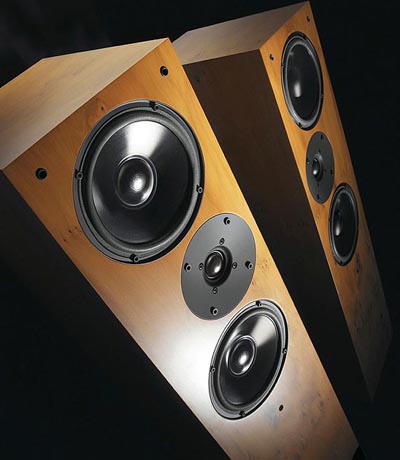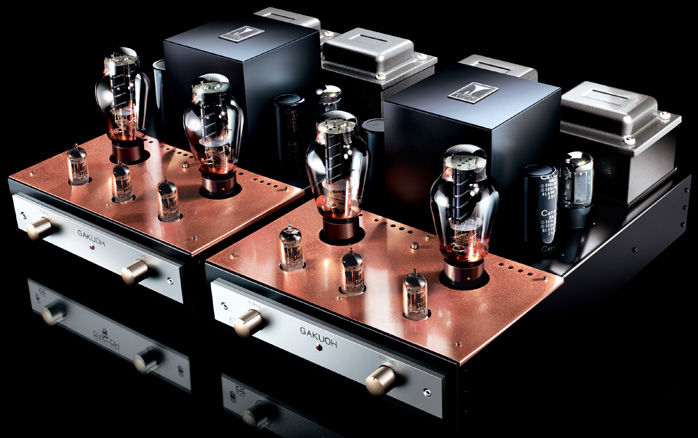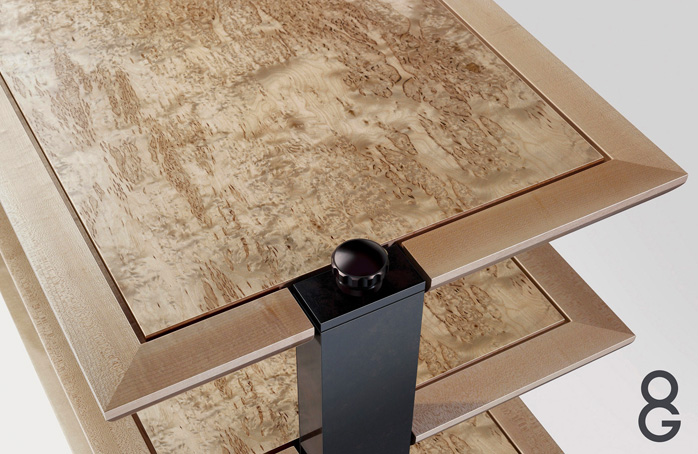This review page is supported in part by the sponsors whose ad banners are displayed below |
 |
On simplicity: Our compound sensitivity for the Vox Olympian is about 102dB. Even with our little speakers I feel that the more amplifier output stages get paralleled and serialized, the less subjective dynamic range one is left with. The music becomes gray and emasculated like a Mundorf capacitor wearing body armor. That's where higher sensitivity speakers allow simple two-stage amplifier circuits to shine. Even our small speakers are 94dB and work well off the type of valve amps we fancy most.
|
 |
On two-ways: I find three-ways with a high pass, low pass and band pass unappealing because you listen to the midrange through a band pass filter. I don’t like that idea. I’d prefer a two-way with a sub or a two-way with a super tweeter. The Vox Olympian really is a two-way with a super tweeter and subwoofer. What I like about the MTM arrangement we use in our little speakers is that if you listen to a well-done 2-way, there's an uncomplicated simplicity to the presentation that’s musically very valuable. A 5-inch driver with a tweeter can be very coherent but it won’t have any waft, shove, power, bandwidth and extension. You listen to a 10-inch 2-way instead and it’s got some nice chuffy chug but it beams as you move toward the crossover point and it sound like pastels or blotting paper - powdery and grainy in that important zone. Can you make a 6.5-inch driver that works as a two-way? Yes. Can you make an 8-inch drive unit that works in a 2-way? I’ve heard them in the old Snells. Those did it beautifully which I think took some doing. I made a Kondo 8-inch two-way and was so encouraged by the results that it’s something I shall revisit in the future. Those 8-inch Kondo drivers with silver dust caps, paper diaphragms, leather suspensions and Alnico magnets in superb cast baskets were saucy looking things. I had them for a year and took the opportunity to design a crossover for them. We got very good results. It was massive but beautifully proportioned sound.
|
|
| |
With a 6.5-inch driver you can certainly get seamless invisible integration with a tweeter. Now put two of those drivers in parallel and you’ve got the same surface area like a 9.25” woofer. This gives you better traction to go low with some air-moving capability yet the simplicity and legibility of a two-way remain. You also end up with half the excursion, half the IMD and twice the sensitivity. This moves up the spec for the mid/woofers such that our Revelator needs no series resistance to pad it down to match. As you well know, in the catalogues of any driver vendors the HF units are always 3 to 4dB more efficient than the mid/woofers. It’s very difficult to burn efficiency in a tweeter without screwing up the sound. In our small speakers, there's no resistor on the tweeters. The tonal balance by design relies on the paralleled mid/woofers.
The physical tweeter offset is for two reasons – no destructive interference on the front baffle by avoiding equal path lengths to the edge with a golden ratio location; and with toe-in, you’re actually effecting time alignment. With care, those speakers disappear. The single rear port is equidistant to both drive units. And yes, some of my customers want a more illustrious OBX-RW. |
|
|
What we have currently they call too cheap. I won’t raise the price because the speaker is what it is. Eventually we’ll simply need a bigger Avatar that’s more expensive because it’s demonstrably better. A bronze substrate chemically patinated for the driver mounts would perhaps look and sound terrific?
On scratching one's head: We cryogenically treat the binding posts, hookup wiring and capacitors of the Vox Olympian and R models with a UK facility. We tested two firms with the very same parts which nonetheless returned sounding wildly different. Unfortunately both companies were quite cagey about details of their deep immersion processes. All we could do is have our chosen company guarantee that they’ll apply the identical process each time they process our parts. Also, we wanted pure copper binding posts. To get machined rather than stamped ones requires an Alloy usually with a microscopic amount of Tellurium. I didn’t like the sound. You’d think that brass posts—60% copper, 40% zinc—would sound terrible but I’ve heard many I liked. Finally, I know that they don't look slick but stamped baskets sound good. We’ve compared virtually the same drive unit in a cast magnesium basket and a stamped God-help-us steel basket with all the bad connotations and unmarketability which attach to it. The stampers sounded fluid and powerful with quiet backgrounds whereas the Magnesium versions were bleached and gray.
|
|
|
On outboard vs. onboard crossovers:
With our IBX you can hear an intimate grip with the crossover onboard; with the OBX's outboard crossover you get a slightly looser sound (nothing objectionable) but enjoy the advantage of more space to lay out the crossover properly. All parts are 12 – 15 inches apart and rightly oriented. That sounds better than having them 9 or 10 inches apart which sounds better than 7 or 8 inches. So we house our external crossovers in standard-width boxes. You could place them in an equipment rack if you wanted. Not only does offboarding remove microphonic parts from the high-pressure environment of the speaker enclosure, you can also mount them on an elastomeric support structure. This gives a far quieter background for greater low-level ambiance retrieval, filigree and upper harmonics; better saturated tonal colors; higher textural differentiation; and a more heterogeneous presentation. It’s also calmer and more musically organized to become a net gain by some margin.
|
 |
Many two-ways fall apart when the going gets tough. They get confused because the crossover points start to drift due to improperly laid-out components. The inductance values change and the parts start talking to each other. You see a lot of speakers with their inductors oriented wrongly relative to each other and the capacitors and resistors. Impeccable crossover layout is vital. We’ve applied exhaustive mental illness to this subject to be certain of its importance. It’s a recipe I wouldn’t mess with now. On the Olympian, many of its target customers probably wouldn’t want to be bothered with external boxes but we will offer that as an option. For the internal solution, the components are laid out widely on an elastomeric substrate and housed in fully sealed cavities.
On Vox Olympian DNA: I started my design work with the RH330 (330Hz cut-off radial horn) because I developed a relationship with Vitavox and obtained good results from it. Since I didn’t have any problems with the driver, I remained on the path. I did have a small issue with it in the Air Partner which was a little tubby and chesty but otherwise loved it. The Air Scout was much snappier and had a crisply walking bass but didn’t really go low enough to require the sub I designed for it. So with both the Air Partner and Air Scout, I ran the RH330. In the intervening gap between those models and horns really coming to the fore—in a small way we might have had an influence on that because whenever we showed our horns at hifi shows, the reactions were always favourable and powerful signs of a world beyond infinite baffle and reflex speakers—I encountered certain horn designs I admired even if they sounded slightly weak or fragile. Intellectually, the spherical geometries Acapella and Avantgarde pursue are very appealing with their symmetrical radiation rather than our controlled dispersion. I was simply content with the results I obtained from other solutions and show demos of spherical horns did nothing to persuade me to pursue them. I found them a bit plasticky.
|
 |
I did however have experience with exponential sectioned solutions which sounded terrific. I also had huge respect for the brains and engineering behind Vitavox’s David Young now retired. I heard of people preferring the sound of his arrays without the four-cell subdivisions. So I tried some without the fully sectioned vanes to the front. There was a certain advantage to the full vanes as I used them in the Air Scout and Air Partner even though they looked a bit brutal. As you moved across the room in an arc, they would focus and defocus, focus and defocus. Then I listened to the non-sectioned Vitavox and liked it very much. I damped it with polyurethane foam in a 300Hz horn, then laminated Birch ply, then Beech ply to like that even more (identical geometry, different build material). It didn’t sound cuppy, nasal, beamy or suffered any particular hot spots. I don’t care if people cite a particular polar response. I go with what I can hear. It’s also easier to make my kind of horn structurally massive. Doing the same with a spherical horn would quickly look ungainly. But I’m sure you could do a spherical horn really well if you applied yourself.
|
I had some Tractrix geometries made for the Vitavox S2 midrange unit and tried using that on top as a tweeter which didn’t work for me. I then looked at the performance of the 2002 and 4003 drivers and bought them. I far preferred the 2002* in my application and also had a disposition towards the Alnico magnet over Neodymium. I’ve actually not heard a Neodymium midrange driver which I like. There’s something rather cold-hearted about them that to me lacks humanity. I got on really well with the 2002 however and wouldn’t care if it had a chocolate magnet. I tried all kinds of geometries on its front, buying off-the-shelf geometries for endless experiments which ended in a graveyard at work. I finally ended up with what we have today, that very unusual truncated section of an exponential which we evolved over time. On the HF unit with that slot-dispersive arrangement, I’ve used bullet units with 30:30 dispersion but unless you’re sitting very far from your loudspeakers, I think bullets are inappropriate for domestic use. If you listen to a variety of slot dispersives like a JBL 2405 and even something as modest as a Beyma, they have a dispersion pattern that’s far more attractive than bullets.
On the 703 I haven’t modified the horn geometry at all. It's exactly as TAD supplies it. We clamp it in that massive bronze pod which certainly helps. I’m sure that if you put your mind to it, you could make Tractrix or conical horns work beautifully. There are many ways to skin a cat. You take the technology, make your choice and the DNA of your loudspeaker becomes its crossover. The real secret is that there is no secret, no inherently superior approach. You must pursue your chosen path to its very end and not be prematurely content. Keep looking, keep trying different things – including different music, different rooms and different listeners.
|
|
|
 |
* The TAD 2001 is a 6.9kg tri-slot phase plug 1-inch Beryllium compression driver with 19.500 Gauss magnetic flux density, an Alnico 5 motor and 450Hz to 27.000Hz response at 111dB sensitivity. |
|
|
|
On downscaling:
While some readers may wish for a financially downsized Vox Olympian, it would still be expensive. That’s the annoying thing. Consider the drive units. The 703 and 2002, S2 and AK151 are darn expensive. If you could get rid of the two tweeters and use just one; if you could get rid of the S2 and use something respectable, you could get rid of that bass driver which is very dear. There are plenty of cheap bass drivers that work very well. There’s a huge amount of R&D from the very big companies that have gone into bass drive units for professional applications. There value for money becomes a real knockout. It’s the upper range drive units that seem more difficult to execute well.
On adaptability: As I learned with the Air Partner, you take such a speaker into different rooms and suddenly you have no treble. Or far too much treble, no bass to speak of and no meaningful effective way to rectify any of it since your crossover is locked in. That’s why the Vox Olympian had to be so very adjustable. I experimented with L-pads and T-pads for the back panel pots but couldn’t get as good a result as with simple series resistors. Because you vary impedance with such adjustments, the drive units had to be movable to compensate. It would be lovely if an L-pad did the business with its constant impedance but the sonic losses were simply too high.
The crossover rheostats are made for us by a US supplier to our spec, with wire of our choosing wound on their standard rheostat former in the direction we indicate. We use those same rheostats in the RW models.
|
 |
On chassis materials:
In Kondo’s amusingly Yinglish brochure, it says that they use copper in their chassis for the sound of stretch which I take to mean supple and vibrant. And they write that they use silver for the sound of shiver which is self-explanatory. Copper chassis to me sound rich, resolved, full and kind, not dry, striated and monochrome like aluminium which is gray and foreshortened. Steel is dark and granulated. For speakers, wood or bronze are far better.
|
 |
The prototype Vox Olympian used a Birch ply midrange horn. I became really despondent at that stage because the sound was slightly dry, opaque, desiccated and pale. It lacked succulence. It was neither supple nor alive. The first change was to a Beech midrange horn. That was lovely. Then we went for a full-on Beech bass enclosure. The difference in sound without any geometric changes was profound. If one had all the time and money in the world, one could romp through endless materials at a heady clip. While Beech as a material is extremely hard, it doesn’t at all sound hard. I might eventually like to try a midrange horn in Maple. That could sound quite special. Maple guitars have real projection and vividness after all. Of course I wouldn’t want to overcook the midrange. Balance is everything. The difference between the aluminium and bronze bugle was in many ways far more profound than any of the endless crossover permutations. The small energy conducted inside the trumpet, any destructive interference and resonance modes alone there wouldn't seem to explain the magnitude of it. But should I refuse to implement a winning recipe just because I fail to understand exactly how and why it works so exceptionally well?
|
 |
Shop talk conclusion: The most important bits to our work include having a clear vision of what we're trying to sonically accomplish; keeping an open mind; pursuing changes very methodically and with full documentation to be able to rewind or skip back in the process at any point; and to not settle for good enough. All the rest of it is 'just' time and money.
|
  |
 |
|